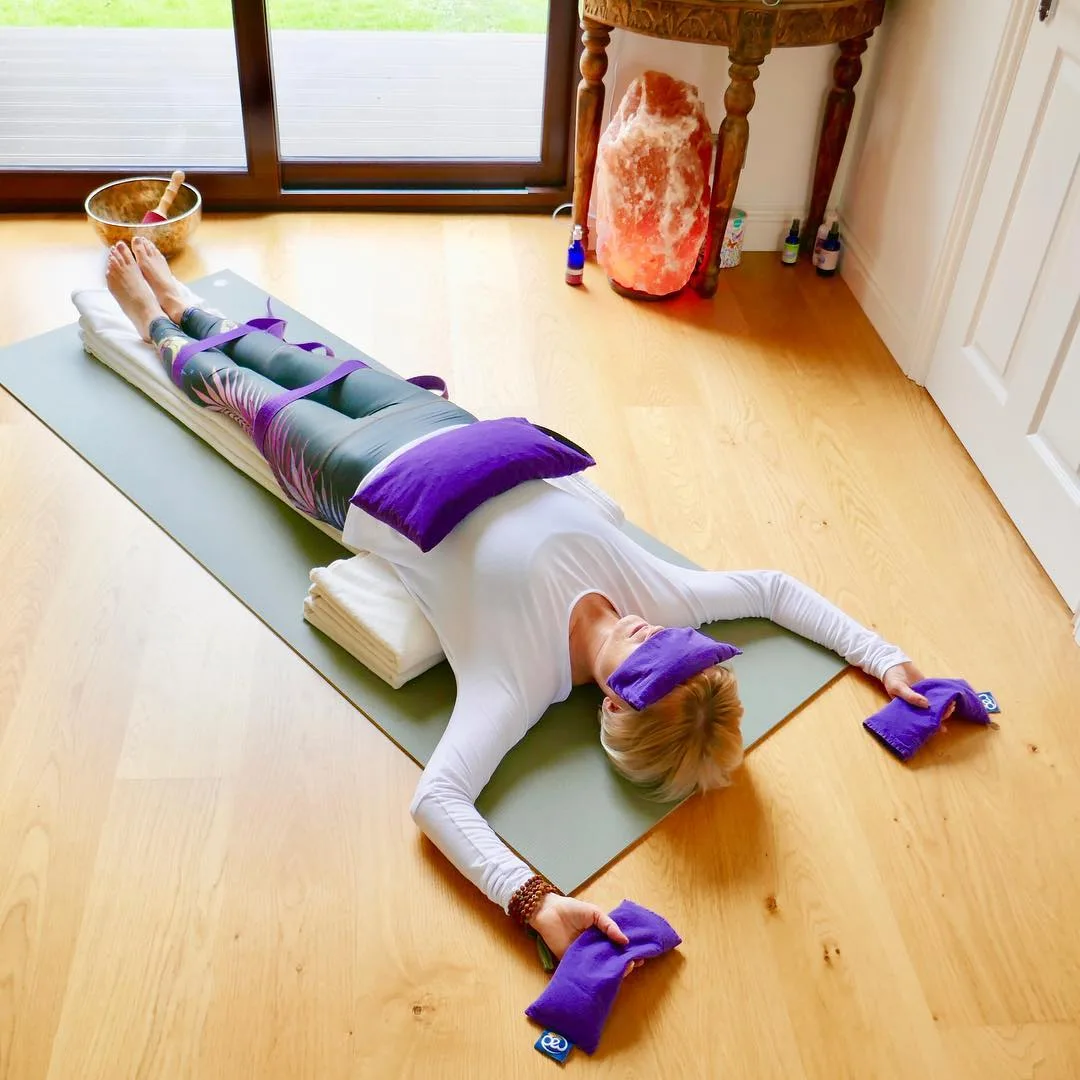Supported Bridge Pose, also known as Salamba Setu Bandha Sarvangasana, is a restorative, or relaxation, or inverted pose, gives you an experience Iyengar calls “negative brain.” Here it is not meant as bad as negative, but as calm, slow and introspective.
This restorative yoga posture is an antidote to living in an age that manipulates your mind and nervous system into being hot, sharp and extroverted.
Information
| Known as: | Salamba Setu Bandha Sarvangasana, Supported Bridge Pose, Salamba Setubandha Sarvangasana Uttana Pada Bolster, Supported Bridge Pose Extended Legs Bolster, Restorative Supported Bridge Pose, Restorative Bridge Pose |
| Sanskrit name: | सालम्ब सेतु बन्ध सर्वाङ्गासन |
| IAST: | Salamba Setu Bandha Sarvāṅgāsana |
| Pronunciation: | sah-LOM-bah SEY-tu BUHN-duh suhr-vuhng-GAHS-uh-nuh |
| Level: | Beginner |
| Type: | Inverted, Back-bend, Relaxation, Restorative Posture |
| Total time: | Up to 15 minutes |
| Drishti: | At ceiling; Eyes closed |
| Chakra: | Swadisthana Chakra |
| Focus: | Spine |
| Indications: | Fatigue, high blood pressure, sciatica, asthma, sinusitis, digestion, reproductive system, menstrual discomfort, thyroid and parathyroid glands |
| Counterpose: | Apanasana (Knees-to-Chest Pose) |
| Preparatory poses: | Virasana, Bridge Pose |
| Follow-up poses: | Restorative yoga poses, Corpse Pose |
| Contraindications: | Neck or spinal injury, pregnancy (after the second trimester) |
Sanskrit Meaning
The Salamba Setu Bandha Sarvangasana is derived from the Sanskrit name, which is made up of six words — Salamba + Setu + Bandha + Sarva + Anga + Asana:
- “Salamba” = “supported or with support”
- “Setu” = “bridge”
- “Bandha” = “caught”
- “Sarva” = “all”
- “Anga” = “limb”
- “Asana” = “pose or posture”
Benefits of Supported Bridge Pose (Salamba Setu Bandha Sarvangasana)
Supported Bridge Pose (Salamba Setu Bandha Sarvangasana) draws fluid out of the legs after prolonged standing, thereby reducing fatigue. Athletes find it beneficial after a long run in helping to reduce pain in the leg and hip muscles. This pose also helps reduce headaches or mental agitation, which are often symptoms of overwork.
However, the physical and mental benefits of this yoga pose are listed below:
- Physical Benefits:
- Opens the heart, chest, neck, and spine
- Alleviates low back discomfort
- Helps alleviate sciatica
- Helps relieve asthma, high blood pressure, and sinusitis
- Relieves menstrual discomfort
- Stimulates pituitary, thyroid, and parathyroid gland function
- Increases circulation in digestive and reproductive organs
- Mental Benefits:
- Reduces stress
- Relieves mild depression
- Relieves anxiety
- Stimulates the nervous system
Supported Bridge Pose (Salamba Setu Bandha Sarvangasana) Practice Guide

Equipment needed
- Props:
- Optional Props:
- Two or more single-fold blankets
- Extra blanket for warmth
- Towel
- Eyebag
- Clock or timer
Supported Bridge Pose Preparation

Place bolster end-to-end to adjust the length of your body. The height of the Prop depends on the length of your torso and the flexibility of your upper part. If your back is harsh, you can start using single fold blanket and gradually increase height. Most people think that in the height measuring 6 to 12 inches work well. If you are long, try 2 Bolster with 2 or more single-fold blankets at the top to make extra height. Make sure that the height of the Prop is also in their length.
Step-by-step instructions
- Sit down, tilt the bolstars, and move a little closer to your back. Use support of your arms to help you lie. Carefully slide up to the end towards your head so that your shoulder touches the floor and you face the roof.
- If you feel any inconvenience in the lower part of your back, tilt your knees and keep your feet either on the floor or on both sides of Bolster.
- To protect the natural curve of your neck, be careful that do not jam your chin into your chest. To resist this trend, use a rolled towel to support vertebra (C7) located on the basis of your neck, near the shoulder.
- Use a standard bath towel, dilute better. Fold the towel in half a long time, and then do one end more than 6 to 8 inches. Start with fold, roll towel and keep it on your neck basis, parallel to your shoulders.
- Do not support the neck where the curve is the largest. Use with roll size so that you are comfortable. You can always reduce the size of the roll and the uncontrolled part can spread below your head.
- Keep an eye on your forehead or your eyes; Keep your arms on a comfortable angle.
- Slowly bring your attention to your breath. Feel the lateral movement of your lungs and ribs with every breath and exit. To increase your discount, let your eyes turn downwards. Drag the energy towards the inside, because the body’s energy opens and spreads.
- As long as you are comfortable, practice Supported Bridge Pose (Salamba Setu Bandha Sarvangasana), for up to 15 minutes. To come out, remove the eyes and slide the bolstors in the direction of your head. With your back on the floor, rest your lower legs on Bolster. Stay for a few minutes, and then roll on one side. Press below your hands and sit down slowly.
Precautions and contraindications
- Supported Bridge Pose is not recommended for people who should avoid inversions:
- People with hiatal hernia, eye pressure, retinal problems, heart problems, or neck problems, and women who are menstruating. If you have any concerns about practicing inverted poses, consult your doctor or health care professional.
- Do not practice Salamba Setu Bandha Sarvangasana:
- If you have spondylolisthesis or spondylolysis.
- After the first three months of pregnancy.
- If you have a sinus infection or respiratory.
- If you have indigestion.
- If you are recovering from whiplash or have any questions about the suitability of the pose for your neck.















